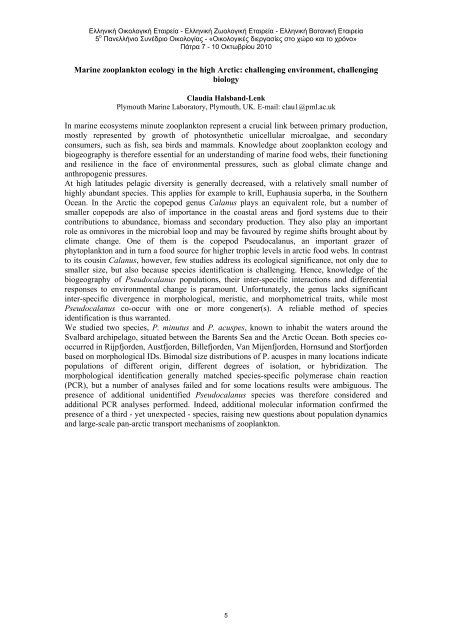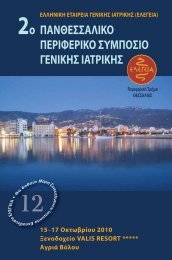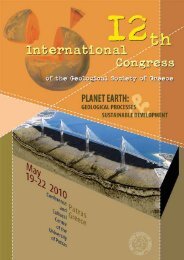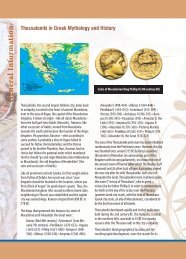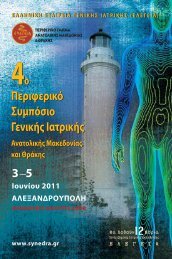Ελληνική Οικολογική Εταιρεία - Ελληνική Ζωολογική Εταιρεία - Ελληνική Βοτανική Εταιρεία5 ο Πανελλήνιο Συνέδριο Οικολογίας - «Οικολογικές διεργασίες στο χώρο και το χρόνο»Πάτρα 7 - 10 Οκτωβρίου 2010Marine zooplankton ecology in the high Arctic: challenging environment, challengingbiologyClaudia Halsband-LenkPlymouth Marine Laboratory, Plymouth, UK. E-mail: clau1@pml.ac.ukIn marine ecosystems minute zooplankton represent a crucial link between primary production,mostly represented by growth of photosynthetic unicellular microalgae, and secondaryconsumers, such as fish, sea birds and mammals. Knowledge about zooplankton ecology andbiogeography is therefore essential for an understanding of marine food webs, their functioningand resilience in the face of environmental pressures, such as global climate change andanthropogenic pressures.At high latitudes pelagic diversity is generally decreased, with a relatively small number ofhighly abundant species. This applies for example to krill, Euphausia superba, in the SouthernOcean. In the Arctic the copepod genus Calanus plays an equivalent role, but a number ofsmaller copepods are also of importance in the coastal areas and fjord systems due to theircontributions to abundance, biomass and secondary production. They also play an importantrole as omnivores in the microbial loop and may be favoured by regime shifts brought about byclimate change. One of them is the copepod Pseudocalanus, an important grazer ofphytoplankton and in turn a food source for higher trophic levels in arctic food webs. In contrastto its cousin Calanus, however, few studies address its ecological significance, not only due tosmaller size, but also because species identification is challenging. Hence, knowledge of thebiogeography of Pseudocalanus populations, their inter-specific interactions and differentialresponses to environmental change is paramount. Unfortunately, the genus lacks significantinter-specific divergence in morphological, meristic, and morphometrical traits, while mostPseudocalanus co-occur with one or more congener(s). A reliable method of speciesidentification is thus warranted.We studied two species, P. minutus and P. acuspes, known to inhabit the waters around theSvalbard archipelago, situated between the Barents Sea and the Arctic Ocean. Both species cooccurredin Rijpfjorden, Austfjorden, Billefjorden, Van Mijenfjorden, Hornsund and Storfjordenbased on morphological IDs. Bimodal size distributions of P. acuspes in many locations indicatepopulations of different origin, different degrees of isolation, or hybridization. Themorphological identification generally matched species-specific polymerase chain reaction(PCR), but a number of analyses failed and for some locations results were ambiguous. Thepresence of additional unidentified Pseudocalanus species was therefore considered andadditional PCR analyses performed. Indeed, additional molecular information confirmed thepresence of a third - yet unexpected - species, raising new questions about population dynamicsand large-scale pan-arctic transport mechanisms of zooplankton.5
Ελληνική Οικολογική Εταιρεία - Ελληνική Ζωολογική Εταιρεία - Ελληνική Βοτανική Εταιρεία5 ο Πανελλήνιο Συνέδριο Οικολογίας - «Οικολογικές διεργασίες στο χώρο και το χρόνο»Πάτρα 7 - 10 Οκτωβρίου 2010Η ξεχασμένη βιοποικιλότητα: αγριομέλισσες στα άνθη της Τελευταίας Εδέμ…των γαρ ορών έστιν ά νυν μέν έχει μελίτταις μόναις τροφήν…Πλάτωνος, ΚριτίαςΘεοδώρα ΠετανίδουΕργαστήριο Βιογεωγραφίας & Οικολογίας, Τμήμα Γεωγραφίας, Πανεπιστήμιο Αιγαίου. E-mail:t.petanidou@aegean.grΆγνωστο αν πραγματικά ο Αϊνστάιν εκστόμισε τη βαρυσήμαντη, για την αξία της μέλισσας στηζωή του ανθρώπου, ρήση «αν η μέλισσα εξαφανισθεί από προσώπου γης, μένουν στον άνθρωποτέσσερα χρόνια ζωής: χωρίς μέλισσες δεν θα υπάρχει πλέον επικονίαση και χωρίς επικονίαση δενθα υπάρχουν τα φυτά, τα ζώα, ο άνθρωπος». Η σπουδαιότητα, πάντως, της ρήσης είναιδηλωτική του προβλεπτικού πνεύματος και συναφής με το ανάστημα του λαλήσαντος: Πολύαργότερα από τους χρόνους του Αϊνστάιν έγινε σαφές ότι οι μέλισσες, όπως και άλλοιεπικονιαστές, διαδραματίζουν κεντρικό ρόλο στη διατήρηση της οικοσυστημικής λειτουργίας(π.χ. υποστήριξη της τροφικής πυραμίδας των οικοσυστημάτων), προσφέρουν ανεκτίμητεςοικοσυστημικές υπηρεσίες στη διατήρηση της βιοποικιλότητας και των βιοκοινοτήτων (εγγενήςαναπαραγωγή και εξέλιξη φυτών) και ότι η οικονομική αξία τους είναι κεφαλαιώδης για τηνπαγκόσμια γεωργική και άλλη πρωτογενή παραγωγή. Συνελόντι ειπείν, η επικονίαση αποτελείβιοτικό πόρο πολύτιμο και ταυτόχρονα ανεκτίμητο.Σε παγκόσμια κλίμακα, οι επικονιαστικές υπηρεσίες προσφέρονται από πληθυσμούςεξημερωμένων και, κυρίως, άγριων επικονιαστών, στην πλειονότητά τους εντόμων, μεταξύ τωνοποίων τη σημαντικότερη ταξινομική – λειτουργική ομάδα αποτελούν οι μέλισσες (Apoidea:Hymenoptera). Προς αποφυγή παρεξηγήσεων, η κοινή μέλισσα (Apis mellifera) αποτελεί μόνοένα από τα περίπου 25.000 είδη μελισσών που εκτιμάται να υπάρχουν παγκοσμίως.Η ποικιλότητα και η διαθεσιμότητα των πληθυσμών των επικονιαστών επηρεάζονται από μιασειρά περιβαλλοντικών αλλαγών και άλλων αιτίων, με επιπτώσεις εν πολλοίς άγνωστες στηβιοποικιλότητα, λειτουργία και παραγωγικότητα των οικοσυστημάτων. Γι’ αυτό, κατά τιςτελευταίες δεκαετίες και σε παγκόσμια κλίμακα, υπάρχει αυξανόμενη ανησυχία σχετικά με τηδιατήρηση της ποικιλότητας των επικονιαστών. Ως τεκμηριωμένα ή πιθανά αίτια μείωσής τηςαναφέρονται, μεταξύ άλλων, η απώλεια και ο κατακερματισμός των ενδιαιτημάτων, οι αλλαγέςχρήσεων γης (π.χ. αστικοποίηση, βόσκηση, φωτιές), η απώλεια της φυτικής ποικιλότητας, ηχημική καταπολέμηση των καλλιεργειών, διάφοροι παθογόνοι οργανισμοί και παράσιτα, ηαλλαγή κλίματος και, τελευταία, το φαινόμενο της Διαταραχής Κατάρρευσης Αποικίας.Ως απόκριση στα παραπάνω, η μείωση της ποικιλότητας των επικονιαστών αντιμετωπίζεταισήμερα με προτεραιότητα από μεγάλους οργανισμούς και πολιτικές κρατών, ως μία από τιςμέγιστες απειλές του πλανήτη, αφού θεωρείται ότι έχει παρόμοια εμβέλεια και επιπτώσεις,όπως η πλανητική αλλαγή, η απόρριψη χημικών στο περιβάλλον και οι βιολογικές εισβολές.Ταυτόχρονα, υλοποιούνται πολλά εθνικά και περιφερειακά προγράμματα σχετικά με τηνποικιλότητα των επικονιαστών, δεδομένου ότι οι γνώσεις μας περί της κατανομής, αφθονίας καιδυναμικής των πληθυσμών τους στο χρόνο, αλλά και οι απειλές που οι επικονιαστέςαντιμετωπίζουν, είναι πολύ περιορισμένες. Εκτός από την ποικιλότητα των επικονιαστών,σχετικά περιορισμένη είναι και η γνώση που αφορά στις επικονιαστικές υπηρεσίες, ειδικότεραως προς την επάρκεια (ποσότητα) και καταλληλότητά (ποιότητά) τους.H Μεσόγειος υποστηρίζει μεγάλο μέρος της μελισσοποικιλότητας του πλανήτη, αποτελώνταςένα από τα ζωντανά κέντρα ειδογένεσης μελισσών. Αν και τις τελευταίες δύο δεκαετίες υπήρξεαξιοσημείωτη πρόοδος στην έρευνα της επικονίασης στη μεσογειακή περιοχή, τααποτελέσματα πόρρω απέχουν από του να συνθέσουν την πραγματική εικόνα της κατάστασης,όχι μόνο σε ό,τι αφορά την ποικιλότητα, αφθονία και κατάσταση διατήρησης των πληθυσμώντων επικονιαστών, αλλά και σε ό,τι αφορά τη λειτουργική τους αποτελεσματικότητα σταπλαίσια της βιοκοινότητας στην οποία εντάσσονται. Όπως αναμένεται, οι επικονιαστές είναι οι6
- Page 1 and 2: Στη μνήμη του Καθηγ
- Page 3 and 4: Ελληνική Οικολογικ
- Page 5: Ελληνική Οικολογικ
- Page 9 and 10: Ελληνική Οικολογικ
- Page 11 and 12: Ελληνική Οικολογικ
- Page 13 and 14: Ελληνική Οικολογικ
- Page 15 and 16: Ελληνική Οικολογικ
- Page 17 and 18: Ελληνική Οικολογικ
- Page 19 and 20: Ελληνική Οικολογικ
- Page 21 and 22: Ελληνική Οικολογικ
- Page 23 and 24: Ελληνική Οικολογικ
- Page 25 and 26: Ελληνική Οικολογικ
- Page 27 and 28: Ελληνική Οικολογικ
- Page 29 and 30: Ελληνική Οικολογικ
- Page 31 and 32: Ελληνική Οικολογικ
- Page 33 and 34: Ελληνική Οικολογικ
- Page 35 and 36: Ελληνική Οικολογικ
- Page 37 and 38: Ελληνική Οικολογικ
- Page 39 and 40: Ελληνική Οικολογικ
- Page 41 and 42: Ελληνική Οικολογικ
- Page 43 and 44: Ελληνική Οικολογικ
- Page 45 and 46: Ελληνική Οικολογικ
- Page 47 and 48: Ελληνική Οικολογικ
- Page 49 and 50: Ελληνική Οικολογικ
- Page 51 and 52: Ελληνική Οικολογικ
- Page 53 and 54: Ελληνική Οικολογικ
- Page 55 and 56: Ελληνική Οικολογικ
- Page 57 and 58:
Ελληνική Οικολογικ
- Page 59 and 60:
Ελληνική Οικολογικ
- Page 61 and 62:
Ελληνική Οικολογικ
- Page 63 and 64:
Ελληνική Οικολογικ
- Page 65 and 66:
Ελληνική Οικολογικ
- Page 67 and 68:
Ελληνική Οικολογικ
- Page 69 and 70:
Ελληνική Οικολογικ
- Page 71 and 72:
Ελληνική Οικολογικ
- Page 73 and 74:
Ελληνική Οικολογικ
- Page 75 and 76:
Ελληνική Οικολογικ
- Page 77 and 78:
Ελληνική Οικολογικ
- Page 79 and 80:
Ελληνική Οικολογικ
- Page 81 and 82:
Ελληνική Οικολογικ
- Page 83 and 84:
Ελληνική Οικολογικ
- Page 85 and 86:
Ελληνική Οικολογικ
- Page 87 and 88:
Ελληνική Οικολογικ
- Page 89 and 90:
Ελληνική Οικολογικ
- Page 91 and 92:
Ελληνική Οικολογικ
- Page 93 and 94:
Ελληνική Οικολογικ
- Page 95 and 96:
Ελληνική Οικολογικ
- Page 97 and 98:
Ελληνική Οικολογικ
- Page 99 and 100:
Ελληνική Οικολογικ
- Page 101 and 102:
Ελληνική Οικολογικ
- Page 103 and 104:
Ελληνική Οικολογικ
- Page 105 and 106:
Ελληνική Οικολογικ
- Page 107 and 108:
Ελληνική Οικολογικ
- Page 109 and 110:
Ελληνική Οικολογικ
- Page 111 and 112:
Ελληνική Οικολογικ
- Page 113 and 114:
Ελληνική Οικολογικ
- Page 115 and 116:
Ελληνική Οικολογικ
- Page 117 and 118:
Ελληνική Οικολογικ
- Page 119 and 120:
Ελληνική Οικολογικ
- Page 121 and 122:
Ελληνική Οικολογικ
- Page 123 and 124:
Ελληνική Οικολογικ
- Page 125 and 126:
Ελληνική Οικολογικ
- Page 127 and 128:
Ελληνική Οικολογικ
- Page 129 and 130:
Ελληνική Οικολογικ
- Page 131 and 132:
Ελληνική Οικολογικ
- Page 133 and 134:
Ελληνική Οικολογικ
- Page 135 and 136:
Ελληνική Οικολογικ
- Page 137 and 138:
Ελληνική Οικολογικ
- Page 139 and 140:
Ελληνική Οικολογικ
- Page 141 and 142:
Ελληνική Οικολογικ
- Page 143 and 144:
Ελληνική Οικολογικ
- Page 145 and 146:
Ελληνική Οικολογικ
- Page 147 and 148:
Ελληνική Οικολογικ
- Page 149 and 150:
Ελληνική Οικολογικ
- Page 151 and 152:
Ελληνική Οικολογικ
- Page 153 and 154:
Ελληνική Οικολογικ
- Page 155 and 156:
Ελληνική Οικολογικ
- Page 157 and 158:
Ελληνική Οικολογικ
- Page 159 and 160:
Ελληνική Οικολογικ
- Page 161 and 162:
Ελληνική Οικολογικ
- Page 163 and 164:
Ελληνική Οικολογικ
- Page 165 and 166:
Ελληνική Οικολογικ
- Page 167 and 168:
Ελληνική Οικολογικ
- Page 169 and 170:
Ελληνική Οικολογικ
- Page 171 and 172:
Ελληνική Οικολογικ
- Page 173 and 174:
Ελληνική Οικολογικ
- Page 175 and 176:
Ελληνική Οικολογικ
- Page 177 and 178:
Ελληνική Οικολογικ
- Page 179 and 180:
Ελληνική Οικολογικ
- Page 181 and 182:
Ελληνική Οικολογικ
- Page 183 and 184:
Ελληνική Οικολογικ
- Page 185 and 186:
Ελληνική Οικολογικ
- Page 187 and 188:
Ελληνική Οικολογικ
- Page 189 and 190:
Ελληνική Οικολογικ
- Page 191 and 192:
Ελληνική Οικολογικ
- Page 193 and 194:
Ελληνική Οικολογικ
- Page 195 and 196:
Ελληνική Οικολογικ
- Page 197 and 198:
Ελληνική Οικολογικ
- Page 199 and 200:
Ελληνική Οικολογικ
- Page 201 and 202:
Ελληνική Οικολογικ
- Page 203 and 204:
Ελληνική Οικολογικ
- Page 205 and 206:
Ελληνική Οικολογικ
- Page 207 and 208:
Ελληνική Οικολογικ
- Page 209 and 210:
Ελληνική Οικολογικ
- Page 211 and 212:
Ελληνική Οικολογικ
- Page 213 and 214:
Ελληνική Οικολογικ
- Page 215 and 216:
Ελληνική Οικολογικ
- Page 217 and 218:
Ελληνική Οικολογικ
- Page 219 and 220:
Ελληνική Οικολογικ


